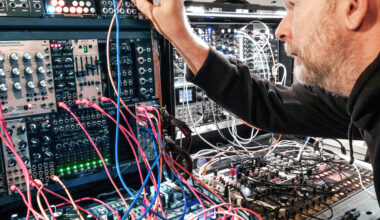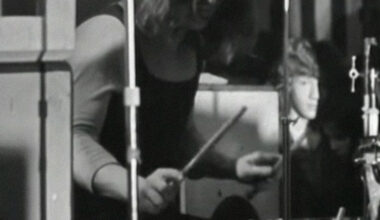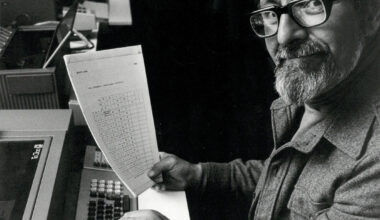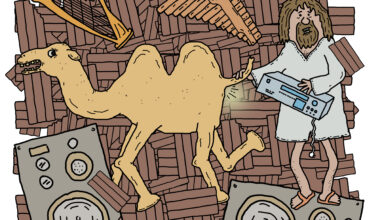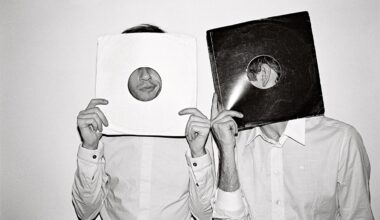When Ciccone Youth’s genius cover versions of Madonna’s ‘Into The Groove’ and ‘Burnin’ Up’ arrived in 1986, how long did it take to work out Sonic Youth were involved? Word soon got around…

An ominous bassline, a wiry guitar and a hissing machine-made percussion track that quickly gives way to a familiar vocal sung by an unfamiliar distorted voice just as echoing, self-conscious handclaps join the mix. “Music can be such a revelation” runs the vocal, poignant as opening lines go, but strangely out of place here.
The track was a cover of Madonna’s ‘Into The Groove’ by a group calling themselves Ciccone Youth. It appeared as the B-side of a 7-inch in the US on the New Alliance label, with another Madonna cover, ‘Burnin’ Up’, taking the A-side. Coming resplendent in a silkscreened sleeve deploying a sensationalist tabloid newspaper story about Madge – created by Andy Warhol as a wedding present to the singer and Sean Penn – it had a DIY, prankster feel suggesting it was a send-up of pop culture in general and Madonna Louise Ciccone in particular.
It was anything but. Ciccone Youth was a pseudonym of Sonic Youth, then a four-piece consisting of Kim Gordon, Thurston Moore, Lee Ranaldo and Steve Shelley. For the project they enlisted fellow Madonna fan, Mike Watt, bassist from Minutemen.
In 1986, Watt was in a musical slump because of the passing of fellow Minuteman D Boon who had died in a car crash the year before. Watt has since said that the Ciccone Youth project motivated him to get back into music. It was in fact Watt’s New Alliance imprint that would issue the single, which Sonic Youth brought with them on their next trip to the UK. Paul Smith’s Blast First label, the band’s UK home, promptly issued the single as a 12-inch, pushing ‘Into The Groove(y)’ to the forefront.
Sonic Youth had paid tribute to Madonna before on 1986’s ‘EVOL’, the album that preceded these drum machine experiments, subtitling the landmark ‘Expressway To Yr Skull’ as ‘Madonna, Sean & Me’. Around the same time, Ranaldo would often play cut-up interludes between songs on stage, including excerpts from ‘Into The Groove’. “We loved Madonna and we loved her early records,” said Ranaldo in an interview for a documentary in 2014.
Ciccone Youth’s version of ‘Into The Groove’ was rough around the edges and a little shambolic to say the least, a direct contrast with the club-friendly smoothness of Stephen Bray’s production of Madonna’s version. There’s a playfulness at work, as sections of the original are slammed against the new arrangement; this felt like a nod to both the artsy experiments of turntablism pioneer Christian Marclay, but also the early years of hip hop, a Bronx export that the Downtown kids had adopted as their own.
To use the geography of New York as a metaphor, if Madonna’s sound was Midtown, Ciccone Youth were a fundamentally Downtown proposition – grubby, raw and punk as fuck. Nevertheless, as musical culture clashes go, it’s odd to hear Thurston Moore duetting with Madonna toward the end of the track.
“I didn’t see it as alien at all,” counters Paul Smith. “Sonic Youth were of their time, and no culture operates in a vacuum. Madonna was a New York-birthed phenomenon and early on she had gone out with Michael Gira of Swans. That’s the beauty of NYC.”
The sessions that produced ‘Into The Groove(y)’ were overseen by ex-CBGB tech Martin Bisi at his BC Studio in Gowanus, Brooklyn. Bisi had first worked with Sonic Youth on their second album, 1985’s ‘Bad Moon Rising’, and some of that record’s magical bleakness appeared on ‘Into The Groove(y)’, giving the track a nauseating grimness where the original was celebratory.
“Technically, that was a very difficult session,” recalls Bisi. “It may sound like we had a backing track with a drum machine, vocals, bass and guitar, and superimposed moments from the Madonna track as samples. It was the other way around – the first thing we did was lay down Madonna’s song on a multi-track tape machine, and then we overdubbed everything else. Overlaying the drum machine was particularly challenging, because nothing would easily stay in sync.
“The mix itself itself reflected us working around these technical difficulties. For instance, the choices of where to use the original Madonna track were partly based on where the synch was better, and the heavy use of delays was a good opportunity to iron out rhythmic issues. In the end, these challenges resulted in something quite experimental. At the time, having to accomplish many things without unaffordable samplers was where hip hop overlapped with experimental music.”
It turned out Madonna herself had no issues with the cover and the use of sections of her original track, though securing her approval relied on Paul Smith pulling a few 1980s music industry strings. Blast First was then financed by Mute, and Daniel Miller had worked with Seymour Stein from Sire to sign Depeche Mode in the US. Sire also happened to be Madonna’s label.
“Clearance was easy,” says Smith. “Seymour played the track to Ms Ciccone and explained the Sonic Youth context, and she was fine with it.”
“We had very little feedback,” Sonic Youth drummer Steve Shelley told the Airstrip*6 fanzine in 1986. “We heard she’d heard it, and wouldn’t sue us if we put it out. She maybe thought it was quite a cool thing. We didn’t mean it in a bad way at all.”
Kim Gordon also went on record in the same fanzine refuting the notion that this was the band making fun of Madonna.
Despite their seemingly endless touring schedule, the band didn’t perform any of their Ciccone Youth material live.
“We could never play shows as Ciccone Youth,” laughed Moore when talking to Cut magazine in 1989. “Come on, The Beastie Boys were bad enough when it comes to having white boys rapping. I’d feel way too self-conscious.”
